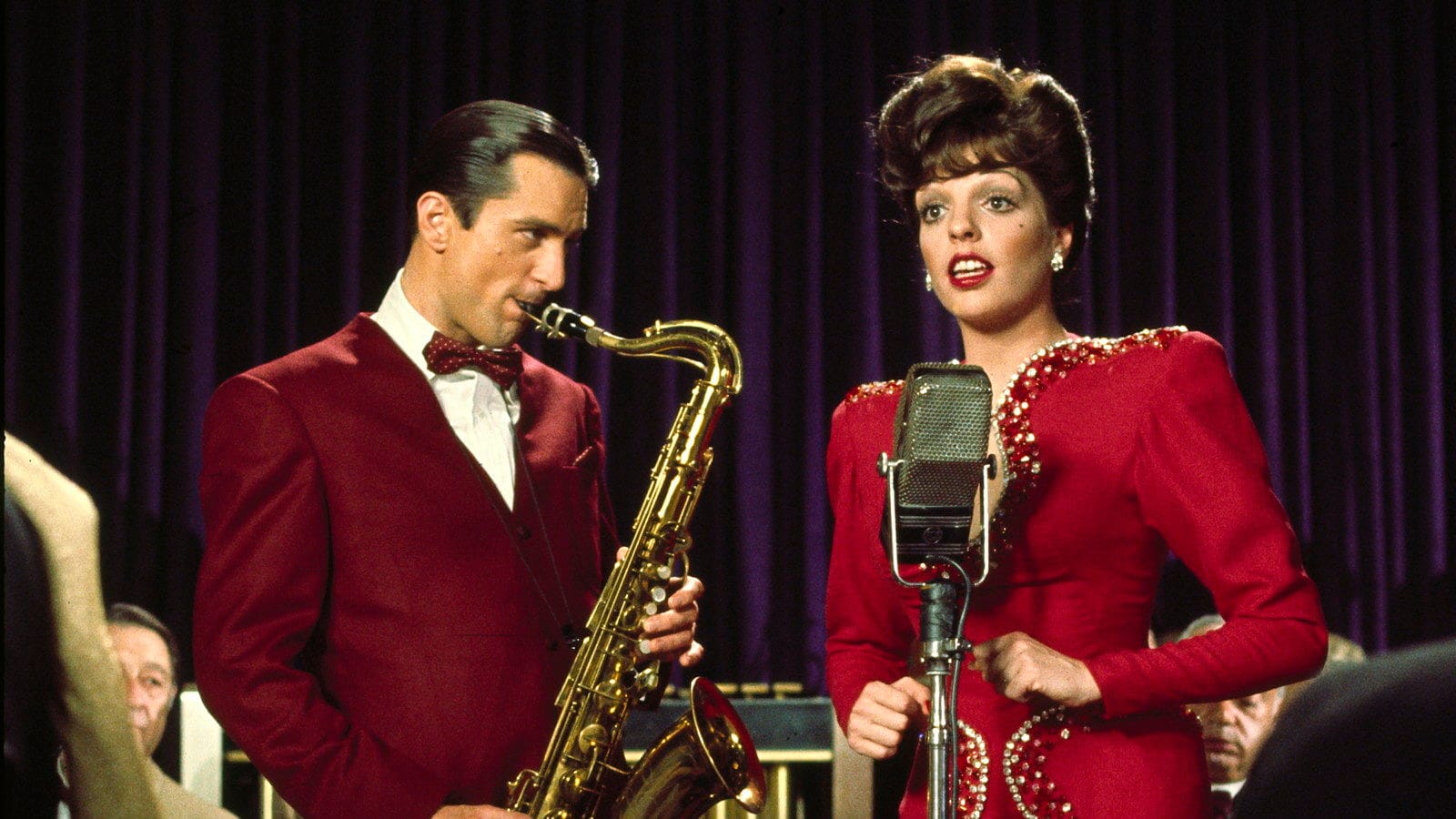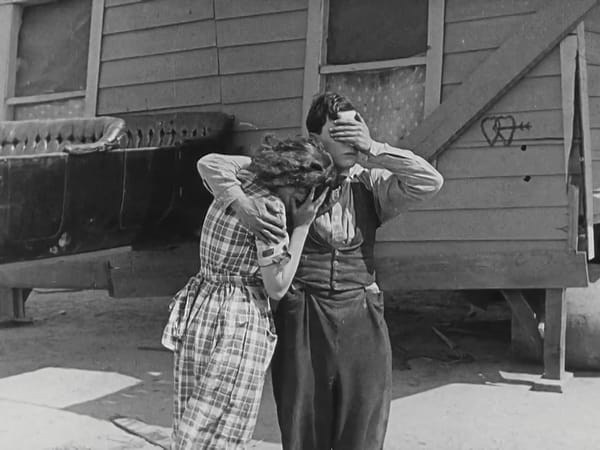What a Gamble! On Martin Scorsese's New York, New York (1977)
At a time when film can be schematic and timid, the huge risks taken by Scorsese have a spicy tingle about them; feeling such deep regret at a missed opportunity is likewise unusual now.


In lieu of an instalment of Psycho., Caspar writes about fascinating experiments from Martin Scorsese and Julia Ducournau
In a key scene in New York, New York, Martin Scorsese’s coked-up curio from 1977, Jimmy Doyle (Robert De Niro) and Francine Evans (Liza Minnelli) head to an audition. Doyle is a fiercely committed jazz saxophonist, and he duly parps out a burst of uncompromising bebop — something which does not endear him to the bandleader holding the audition, who is looking for something more in the Maurice Chevalier vein. At this point, Francine steps in, quickly improvising a rendition of “You Brought a New Kind of Love To Me”, which Doyle is able to riff on with her.
The scene functions — and the degree to which this is conscious is up for debate — as an encapsulation of the whole film’s methodology, and of its qualities and shortcomings. In the first place we have a woman coming to the rescue of a man, and papering over his flaws: this will be the ongoing narrative of the film, as Francine and Jimmy embark on a doomed love affair; but it’s unclear how critical the film is of Jimmy’s machismo, and how much it accepts him and posits him as a plausible love interest. In a second instance, we have Liza Minnelli, singing light cabaret jazz, in a mode made famous by her mother, Judy Garland: it’s impossible not to connect her to Garland, and the film consciously plays on that metatextuality, sometimes brilliantly and occasionally to its detriment. Thirdly: the scene presents an artist who is unwilling to completely surrender to the artistic code he is being asked to. This could be taken as a piece of self-reflection by Scorsese, who in this film is attempting to make an old-school musical but with his own spin on the material. Four: the scene is sort of corny and bad. That set-up requires a wholehearted investment in order to carry it off: you need to accept the artifice of the scene, embrace it, and then hit all the required beats. Scorsese, De Niro and even Minnelli seem embarrassed, and the rhythm slackens where it should pop. Five: the scene is kind of interesting despite and because of that failure. New York, New York is bursting with ideas and cocaine, and its pleasure lies in the risks taken, and the nobility, the grandeur of their failing.
Let’s go into a few of those firstlies and fourthlies together, and see if we can draw any wider conclusions about the current state of cinema. At a time when film can be quite schematic and timid, the huge risks taken by Scorsese have a spicy tingle about them; feeling such deep regret at a missed opportunity is likewise unusual now.
Does New York, New York realise to what extent Jimmy is an arsehole? How critical of him are Scorsese and De Niro? The question hampers the film, because in the opening scenes when he and Francine are thrown together, the audience should feel taken by him; we should sense his appeal, beyond being told simply that he is the protagonist of the movie. Instead, Robert De Niro cooks up a straight-up piece of shit whose vanishing moments of charm fall between the cracks of his megalomania and controlling behaviour. Even when Doyle is chatting Francine up — in a dismal opening scene that should crackle and fizz with repartie, but which seems to miss all the requisite battle-of-the-sexes screwball beats — he seems domineering and humourless, browbeating Francine. At only one point does the scene come to life, when Doyle asks for her phone number and says, “Come on, what am I going to do with it?” and Francine deadpans, “Call it.” There we get a little bit of snap, and that comes from the fact that in this second she is on his level, like all the great wise-cracking heroines from Katharine Hepburn to Claudette Colbert. But immediately again Francine is back to bearing the brunt of Doyle’s domination — and I wonder if that isn’t also the case of Minnelli vis-à-vis De Niro. Was she at ease in that dynamic? How hard did she have to work to create chemistry with him? The improvisatory nature of the film must have meant that she was at times fighting to match him. This leads to us feeling a kind of dispiriting unease, and it severely hampers the mechanics of the film.
Send your questions anonymously to Caspar at this link, no personal information is collected.
Mechanics: that’s the word. Scorsese is seemingly fascinated by all the trappings of the musical, and in some of the film’s best moments pays loving tribute to the Ziegfeld follies of his youth. In particular, a wonderful extended musical sequence cribbed from Singin’ in the Rain (1952) gives Minnelli the chance to show off her pipes, and features some dazzling, ritzy filmmaking full of colour and sparkle, high-kicks, cocaine, and forced perspective. But Scorsese is either reluctant to fully embrace the conventions of the genre, or imagines that he can subvert them or better them. Of course musicals can be revised — indeed, Minnelli had by this time already appeared in Cabaret (1972), a brilliant revisionist musical — but pastiche needs to be wholehearted if it’s to work. Singin’ in the Rain has moments of great expressionistic brilliance, but it also doesn’t neglect certain elements of formula: dances featured at certain intervals, dialogue that hits sharp comedic beats, characters that aren’t too psychologically realistic; a happy ending. Scorsese tries to graft a documentary kind of perspective onto the framework of a musical, and — put simply — it doesn’t work. It’s called a formula for a reason! I’m reminded of furious home cooks online who complain below a recipe that they swapped out butter for coconut oil and sugar for courgettes, and the cake didn’t rise.
And yet, there’s something quite mesmerising about this failure. Peter Bodganovich, a peer of Scorsese’s in New Hollywood, may have made a more ‘successful’ riff on old Hollywood with What’s Up, Doc? (1972), which briskly (and delightfully) riffs on all the smart-alecky tropes of screwball, but that film feels like a light, pleasant, forgettable morsel in comparison with New York, New York. Ambition has to count for something. Scorsese throws in references to The Red Shoes (1948), A Star Is Born (1954), and Meet Me in St. Louis (1944) — and in scenes where Minnelli’s hair is styled like Garland’s in that film, we feel a quite heartstopping fervour, a sense that there is some magic operating here. There are long scenes of brawling; wonderful set-pieces set in pillowy snow filmed like a gay reverie; there is De Niro’s misplaced intensity, pummelling the film’s rhythm; and a totally bathetic ending that feels like giving up.

I was reminded, while watching New York, New York, of Julia Ducournau’s Alpha (2025), which premiered in Cannes last month. The film focuses on a young girl whose mother becomes afraid that she has contracted a virus, leading both of them to reminisce about the infection that claimed the girl’s uncle years before. The film is set in the late 1980s and early 1990s, and therefore it seems logical that the infection we see — which is blood-borne, and can be transmitted by sexual intercourse or intravenous drug use — is HIV/AIDS. But the film never mentions those words, and Ducournau adopts a curious visual aid to present the disease: infected people find that their bodies turn to stone, a kind of crumbling rock like the face of a quarry, which gradually takes over their whole body and turns them to dust. I can’t stop thinking about this decision, which I think on balance does not fully work out for the film. Cinematically, it is a brilliant coup, because it adds great pathos to the narrative, and it lifts the film out of drab, predictable “AIDS film” territory, which can be too beholden to plainness and realism. The effect of the stony bodies is quite striking, and the metaphor works rather well with the Berber mythology that the film sets out; when victims of the disease turn to powder, and their dust swirls around in the world of the living, that feels like a beautiful image to me. And yet, it is a huge gamble that ultimately does a disservice to the film’s narrative, because it robs it of its connection to reality. It’s also not a very good parallel for HIV/AIDS in that the infection was not always visible from the get-go; it also muddles particularities of sex, sexuality, and identity that are crucial to an understanding of the disease. That liberty taken by the film — a mythologising of a real epidemic, which is also quite coy about homosexuality — is ultimately infelicitous. And yet, what a gamble! What competing elements of failure and success!
Ducournau’s film was met with derision in Cannes (although it also found some passionate defenders), but I was struck by how rare that feeling is now — those ideas of outsize ambitions, a director who won’t take notes, a film taking too many liberties, a vision that doesn’t quite cohere. Whatever Alpha may get wrong, I’m struck by the valour of its flaws.
New York, New York was the first film that Scorsese made after his Palme d’Or winner (Taxi Driver, 1976), at a time when producers and star names opened up for him, and he found himself in possession of freedoms that became the film’s undoing. In Scorsese on Scorsese, he says: “It was an experimental situation and, in retrospect, I don’t think we should have been given that free a hand. It was a mess, and it’s a miracle that the film makes any kind of sense. At times I think it became brilliant, but for the sake of the little brilliant pieces we lost too much of the whole.” Alpha is Ducournau’s first film after her Palme d’Or winner (Titane, 2021), and I believe that every word in Scorsese’s statement could apply to Alpha. The film does — miraculously — make a kind of a sense, and there are brilliant touches; the whole film loses something, though, by its obstinacy in not playing by the rules.
Send your questions anonymously to Caspar at this link, no personal information is collected.




